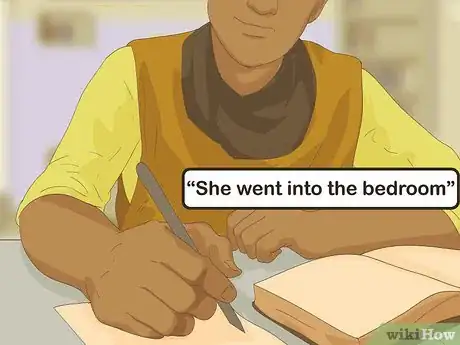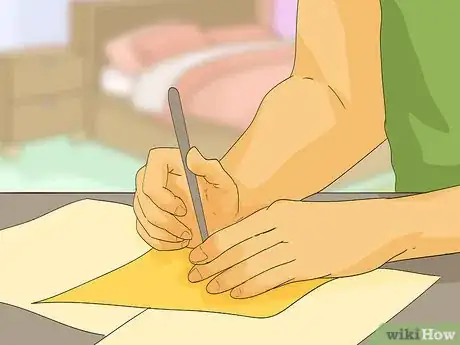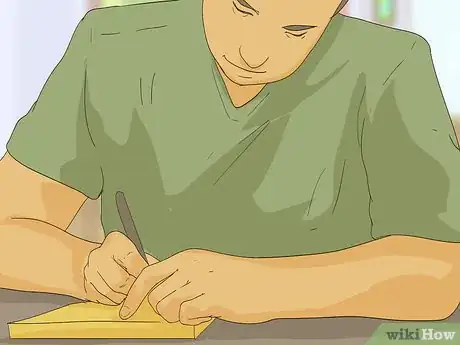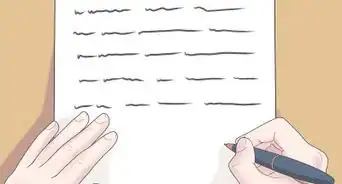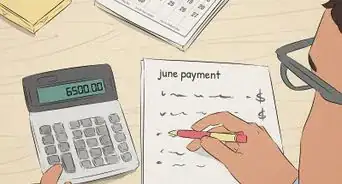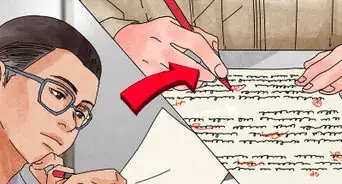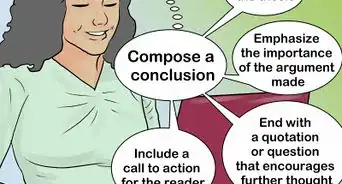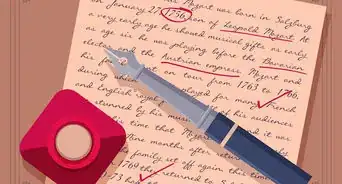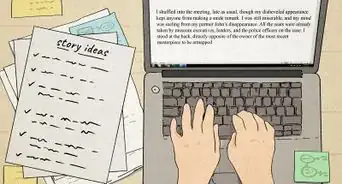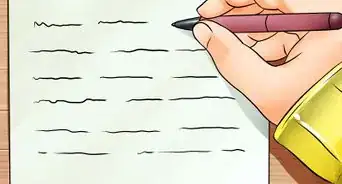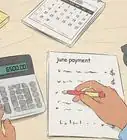This article was co-authored by Grant Faulkner, MA. Grant Faulkner is the Executive Director of National Novel Writing Month (NaNoWriMo) and the co-founder of 100 Word Story, a literary magazine. Grant has published two books on writing and has been published in The New York Times and Writer’s Digest. He co-hosts Write-minded, a weekly podcast on writing and publishing, and has a M.A. in Creative Writing from San Francisco State University.
wikiHow marks an article as reader-approved once it receives enough positive feedback. In this case, 88% of readers who voted found the article helpful, earning it our reader-approved status.
This article has been viewed 582,225 times.
Freewriting is a great way to generate thoughts on the page. You might freewrite if you are experiencing writer’s block or if you’re struggling to come up with new ideas. To do a freewrite, start by choosing a prompt. Then, write to the prompt with a timer and no distractions. You can then create a freewriting practice where you get in the habit of doing a freewrite regularly.
Steps
Choosing a Freewriting Prompt
-
1Pick a theme, location, or emotion as a prompt. To do a free-write, you need a writing prompt to help frame the exercise. You can create your prompts by focusing on a theme like love, loss, or power. You can also choose a particular location as the prompt, such as the doctor’s office, your parent’s home, or a rocket ship on Mars.[1]
- Emotions can also work as prompts. Focus on strong emotions like anger, rage, sadness, excitement, or fear.
EXPERT TIPGrant Faulkner is the Executive Director of National Novel Writing Month (NaNoWriMo) and the co-founder of 100 Word Story, a literary magazine. Grant has published two books on writing and has been published in The New York Times and Writer’s Digest. He co-hosts Write-minded, a weekly podcast on writing and publishing, and has a M.A. in Creative Writing from San Francisco State University.Professional Writer
 Grant Faulkner, MA
Grant Faulkner, MA
Professional WriterYou don't always need a prompt when you're freewriting. If you have an emotional or psychological obstacle between you and the page, try getting up every morning and freewriting two pages. You don't necessarily need a prompt. Instead, try putting any words you want on the page. Punctuate or don't punctuate; the point is not to worry about what you're writing or what people might think of it.
-
2Write about a real or imaginary person as a prompt. Another option is to use a real-life person as a prompt for the free-write, such as your teacher, best friend, or pet. You can make up a person and use them as a prompt as well. Sometimes using a generic term for a person, like “father,” “lover,” or “enemy” can work well as prompts.
- Using a person as a prompt may be especially useful if you are struggling with creating a character in a story. Do a free-write in the voice of the character to help you generate ideas for the story.
Advertisement -
3Use your writing as a prompt. You can also make up your prompts using lines from your writing or the writing of others. Flip through your favorite book and pick a sentence or phrase at random. Then, use this as the prompt for the free-write. You can also choose a line you like from your writing or a line that you are stuck on in a story.
- For example, you may choose a sentence like “She went into the bedroom” as the prompt. This can then be the start of free writing.
-
4Look for freewriting prompts online and through Apps. You can find many writing prompts online that you can use for free writing. Choose a simple prompt to get you started. Or, go for a wacky, creative prompt that will help with your writer’s block.[2]
- You can find writing prompts online at Writer’s Digest.com and Daily Writing Tools.com.
- You can also get prompts through a writing App. Download writing Apps like Prompts or Write About This on your phone or computer to get free writing prompts.
-
5Ask a teacher or mentor for prompts. Ask a writing teacher or an English instructor at school for writing prompts. Talk to a writing mentor and request prompts from them. Good instructors will often have prompts on hand that they can share with students.
Doing the Freewrite
-
1Remove all distractions from your area. Switch your phone to silent and turn off the internet on your computer. Close your door, if you have one, and let others around you know you are not to be disturbed. Block out any loud noises or distractions so you can focus on the free-write.[3]
-
2Use a computer, or a pen and paper. Some people prefer using a computer as they feel comfortable typing. Others prefer a pen or pencil and paper so they are not tempted to click around on their computer during free writing. Choose whatever works best for you.
-
3Place the prompt in front of you. Have the prompt written down in front of you? This will help you think of ideas as you write and act as a guide for free writing.
-
4Use a timer. Get a stopwatch or use a timer on your cellphone or computer. Freewrites are timed to ensure you stay focused and write. Usually, free writes are done for 10-15 minutes.[4]
- You can make the free-write longer, 15-30 minutes if you want to go for it and write for a while.
-
5Write without stopping during the allotted time. Put your pen to paper or click open a blank document on your computer and set the timer. Then, with the prompt in mind, start writing. Respond to the prompt. Try not to read over what you write or edit it in any way. Simply write, moving forward on the page.[5]
- Once the timer goes off, you can stop writing and read what you have written. Avoid doing this during the freewrite, as this will only distract you and force you to stop writing.
- You can then decide to keep the free-write and use it to create a new piece or add lines from it to an existing piece. You can also discard it or share it with someone else.
Creating a Freewriting Practice
-
1Do one free-write a day. If you enjoy doing freewrites, make it a daily practice. Get in the habit of doing one free write a day. Use a different prompt each day to challenge yourself. Return to prompts that you found difficult and try them again.
- You can use a writing app to make it easy for you to find a different prompt to write to each day.
-
2Use freewriting to help break writer’s block. Freewriting is also a good way to break through writer’s block. Get in the habit of doing a free write whenever you feel writer’s block cropping up. Sit down and do a free-write. Then, return to whatever you are trying to write. Often, you will find it easier to work through the block and get writing.[6]
-
3Expand on the freewrite to create a new piece. Sometimes you do a freewrite that you like or find interesting. Do not be afraid to take a freewrite and expand on it to create a new story or piece. Pick outlines or moments you like in the freewrite. Then, use them in an original piece.[7]
Sample Freewrites
Community Q&A
-
QuestionIs this a way to get over writer's block?
 Community AnswerYes. It can help get over writer's block. Just write what you feel like. If this does not help, you can read to get inspiration or come up with some little details or some lists for random topics.
Community AnswerYes. It can help get over writer's block. Just write what you feel like. If this does not help, you can read to get inspiration or come up with some little details or some lists for random topics. -
QuestionCan you list some things we could freewrite about?
 Community AnswerIt is hard to determine what you might personally want to write about, as that's truly personal to your interests. However, general areas in which you might be inspired include: Emotions, moments of realization in your life, favorite things, animals, nature, gaming, travel, role models, dreams, food, future hopes, and so on.
Community AnswerIt is hard to determine what you might personally want to write about, as that's truly personal to your interests. However, general areas in which you might be inspired include: Emotions, moments of realization in your life, favorite things, animals, nature, gaming, travel, role models, dreams, food, future hopes, and so on. -
QuestionWhat is a good amount of time to free write for?
 Community AnswerThere is no set time, as free writing is not something to be confined by a deadline. The best advice is to write for as long as the creativity flows with ease and when it starts to feel hard and no longer interesting, that's the moment to stop.
Community AnswerThere is no set time, as free writing is not something to be confined by a deadline. The best advice is to write for as long as the creativity flows with ease and when it starts to feel hard and no longer interesting, that's the moment to stop.
References
- ↑ https://www.nytimes.com/2018/04/12/learning/over-1000-writing-prompts-for-students.html
- ↑ https://www.nytimes.com/2018/04/12/learning/over-1000-writing-prompts-for-students.html
- ↑ https://www.grammarly.com/blog/free-writing/
- ↑ https://www.lynchburg.edu/academics/writing-center/wilmer-writing-center-online-writing-lab/drafting-a-document/freewriting-techniques/
- ↑ https://writingprocess.mit.edu/process/step-1-generate-ideas/instructions/freewriting
- ↑ https://www.grammarly.com/blog/free-writing/
- ↑ https://writingcenter.unc.edu/tips-and-tools/brainstorming/
About This Article
To freewrite, start by choosing a writing prompt by picking a theme like an emotion, person, or location. For example, you could choose an emotion such as anger or love, or a location like your doctor’s office or a rocket ship on Mars. Next, find a quiet area, set a timer for 10-15 minutes, and write in response to the prompt without stopping. Then, create a daily writing practice using a different prompt each day to help break through writer’s block or expand on your freewrites to use them for an original story. For more tips from our Creative Writing reviewer, like how to find prompts online, read on!


